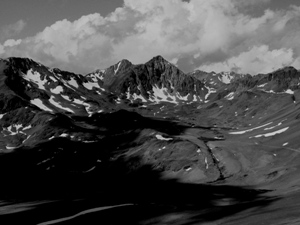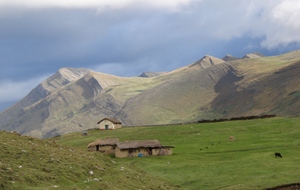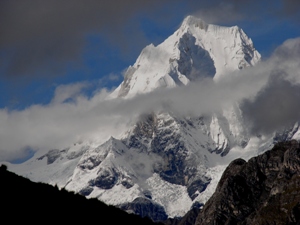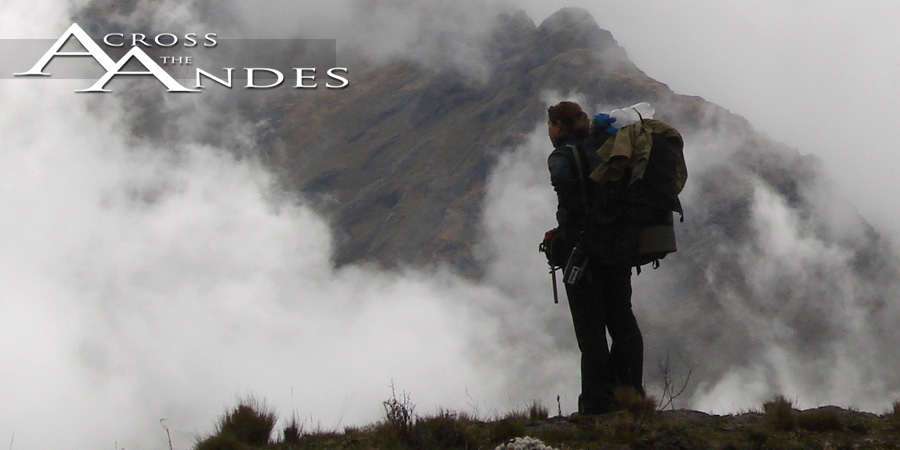Turnin The Compass Around
By Deia Schlosberg
January 19, 2007

This was not a normal section. Annoyingly enough, we didn’t get that much hiking in. We spent a lovely Christmas in Huaraz with our (by now) good friends there. Christmas day night, we took a bus back to where we left off with our hike, in La Union. From here we headed out to Huánuco Viejo, which, according to the guidebooks, is the most significant Incan site outside of the department of Cuzco. I’m not sure what that means, really. But heading south out of town we met a very inebriated man whom Gregg (goodness knows why) asked for directions. We received a ten minute description, complete with wild gestures, of the trail up to the ruins. When we were at last released, we began climbing up the indicated path. Not two minutes in, I turned around to see our friend staggering up behind us. Drunk men at midday are not in short supply in the campo towns of Peru, and from our experience, the best way to avoid half-hour long, extremely repetitive conversations is to either 1) pretend not to hear, or 2) pretend we don’t understand Spanish. This is not to be cruel or rude, it is simply to avoid mild harassment from people who will no doubt have zero recollection of the shunning. Thus, I quickened my pace. We soon heard a shout from below of, “Gringos! Gringos!!” Now we had no choice but to stop and wait or be complete assholes. We stopped. We now had a very drunk guide who would accompany us all the way up the ridge, all the way across the high plain, to the site of the very expansive ruins, and throughout the entire ancient city. By that point, he had sobered up some and was actually giving us some very interesting archaeological tidbits. We ended up giving him some crackers to thank him before he ambled off back to town and left us to search for a campsite for the night.
I won’t go into detail again, but once more, we were visited by the noises here. This time, directly over the Incan site. Weird.
We continued south through some small settlements, mostly along muddy, rutted dirt roads, before departing cross country once again. A woman named Zenobia, who argued with her neighbors that we were, in fact, safe to talk to, ended up giving us fresh milk from one of her cows and eggs from one of her chickens and potatoes from her fields. Sometimes, despite all of our efforts, we’re still freakish novelties, so to be seen as human is extremely nice and refreshing. Several muddy cross country trails and high mountain lakes later, and we were in Queropalca, the small village with the giant cowboy hat in the town square. Hike through South America long enough and these things start to become normal.
From Queropalca we took a bus to Lima, where we met up with my friend Juan for a New Year’s celebration on a beautiful, cliffed beach south of the city. It was during this time that Juan explained to me an interesting and frustrating dynamic going on in Lima now. During the reign of The Shining Path (and the drastic reactions of the military) in the highlands of Peru in the 1980s and early ’90s, many of the campesinos fled to outskirts of Lima. They hoped to escape the violence of the revolutionary group, as well as the government, while making a new life in the big city. Unfortunately, Lima is expensive and it’s difficult to succeed starting with very little. Also, the land around Lima, where most of these displaced people settled, is harsh desert, which makes it impossible for them to live off the land as they had done for generations in the mountains. While struggling to survive there, they did however manage to pick up the anti-campo sentiment of the city, enough to keep them from returning, once the violence ended, to their families that stayed behind. The result is a huge population of people surrounding Lima Central living in very harsh conditions with very little hope of change. As far as our trip went, the rest of our Lima experience after New Year’s was not so lovely as it was expensive and time-consuming. Though on the up-side, I was able to see a doctor, and my knee pain turns out not to be an indication of permanent damage, so onward!

Onward turned out to be a good several days of bus-riding without sleep. This is what happened: Peru, during the months of November through March is in its wet season, meaning that there is rain every day, and during the end of December through the beginning of February, that rain takes the form of wet-to-the-bone downpours that come throughout the day and night, making it impossible for anything to ever dry out, including the trails. Chile, on the other hand, is in the heyday of summer, with long, sunny days and cool, starry nights. Thus, being utterly fed up with sogginess and in the spirit of making the most of every day, we decided to flip-flop the middle portion of our hike and go to Santiago. From there we would hike north to Queropalca, following the dry season up as we go. Once back in the Peruvian mountains, we will return to Santiago to resume our southbound direction to Tierra del Fuego. We were hesitant to make this decision because we abandon our continuity and our witnessing of the slow change of geography and culture that can only happen with moving across the Earth at a human pace. Oh well. Carpe diem, man.
Our first hike in Chile has proved our decision to be a wise one. The sun sure is a fine thing to see after many months, and the brilliance that it brings to color is enough to make one feel reborn. Aside from the climate, Chile itself if a world of difference. “Night and day,” as a friend recently told us, sure has proven true when comparing Peru with Chile. Not as in one is good and the other bad, just very different (including the Spanish accent, which is proving challenging for now). From the border crossing onward, it’s evident that Chile is a much wealthier country. I never really realized at how many different levels a country’s wealth is visible from. Aside from that, Chile has reminded me of what I really appreciate about the U.S., namely, open spaces that are actually nature rather than country. Whereas in Peru, every square inch seems to be farmed or grazed, Chile has entire valleys where the only visible evidence of humans is a very slight foot-trail. It’s refreshing. We even walked through a park devoted entirely to the enjoyment of natural space. Perhaps in a way it represents a distancing from the land, in that there needs to be places set aside to appreciate nature rather than simply living with it as in the country of Peru. However, after hiking for many months with hardly a day where we didn’t come across at least one dwelling, it is refreshing to be back in wilderness, as I would call it. In our first few hours in Chile, we saw an Andean fox, thousands of lizards, a condor, a snake, and more. It’s nice. Chile, around Santiago, is very much like the desert Southwest in the U.S.—mainly Arizona, New Mexico and parts of Colorado. I am feeling very much at home, except of course for the 23, 000 ft. peaks in the background and the glacier-fed rivers and waterfalls. We spent the last few days hiking from desert to high mountain pass with snow to desert again. Chile’s mountains are equally as impressive as anything we’ve seen so far, and I’m eager to experience more of all of it.

Happy New Year to everyone reading these! We’ll stay in touch and continue to get used to the sun setting on our left for a while.







